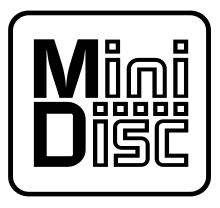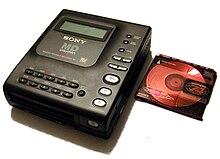 | |
 MiniDisc by TDK, with AA battery for scale | |
| Media type | Magneto-optical disc |
|---|---|
| Encoding | ATRAC |
| Capacity | 60, 74, and 80 minutes |
| Read mechanism | 780 nm semiconductor laser diode |
| Write mechanism | Magnetic field modulation |
| Developed by | Sony |
| Usage | Audio storage |
| Extended from | Compact Cassette, Compact disc |
| Extended to | MD Data, Hi-MD |
| Released | November 1992[1] |
| Discontinued | March 2013 |
| Optical discs |
|---|

MiniDisc (MD) is an erasable magneto-optical disc-based data storage format offering a capacity of 60, 74, and later, 80 minutes of digitized audio.
Sony announced the MiniDisc in September 1992 and released it in November[2] of that year for sale in Japan and in December in Europe, North America, and other countries.[3] The music format was based on ATRAC audio data compression, Sony's own proprietary compression code. Its successor, Hi-MD, would later introduce the option of linear PCM digital recording to meet audio quality comparable to that of a compact disc. MiniDiscs were very popular in Japan and found moderate success in Europe.[4] Although it was designed to succeed the cassette tape, it did not manage to supplant it globally.[5]
By March 2011 Sony had sold 22 million MD players, but halted further development.[6] Sony ceased manufacturing and sold the last of the players by March 2013.[7]
- ^ Woudenberg, Eric. "Sony MZ-1". Retrieved 30 July 2022.
- ^ Cite error: The named reference
sony-endwas invoked but never defined (see the help page). - ^ Sony history Retrieved 1 June 2016
- ^ Emeran, Riyad (8 April 2008). "Music on the Move: MiniDisc". TrustedReviews. Archived from the original on 13 May 2008.
- ^ "Sony bids farewell to the MiniDisc".
- ^ "Sony To Wind Up MiniDisc Walkman Shipments". Nikkei.com. 7 July 2011. Archived from the original on 11 July 2011.
- ^ "Sony says sayonara to MiniDisc, will sell its last players in March". Engadget.com. 1 February 2013. Retrieved 16 May 2016.